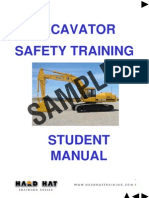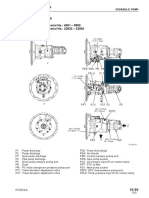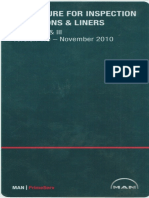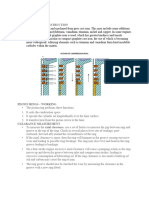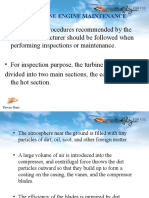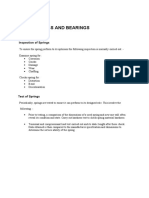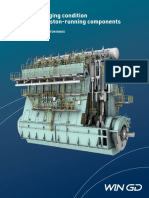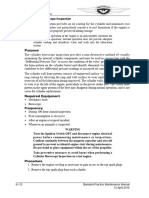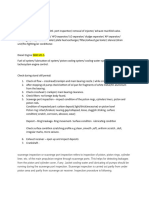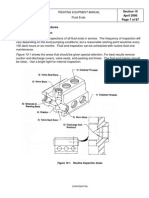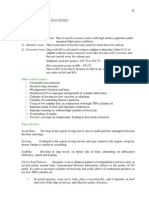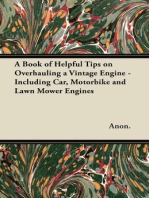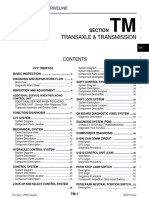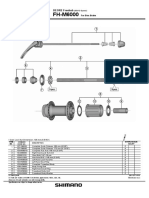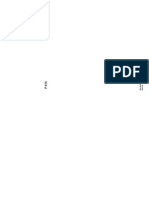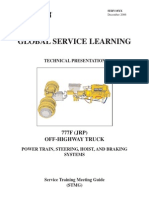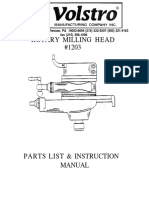Me Up Space Insp.
Me Up Space Insp.
Uploaded by
Trish de LeonCopyright:
Available Formats
Me Up Space Insp.
Me Up Space Insp.
Uploaded by
Trish de LeonCopyright
Available Formats
Share this document
Did you find this document useful?
Is this content inappropriate?
Copyright:
Available Formats
Me Up Space Insp.
Me Up Space Insp.
Uploaded by
Trish de LeonCopyright:
Available Formats
MAIN ENGINE PISTON RING/LINER INSPECTION
Through Scavenge Ports: Interval: Inspection of M/E cylinder liner / piston rings should be carried out every 1,000~1500 hrs. What to check? Piston Crown:
Leakage water in piston bowl. Traces of un-burnt FO. Signs of burning away. Carbon deposits no deposits, light, excessive, thick but worn and polished bright, due to rubbing. Discoloration of the crown due to local burning of fuel. Vertical hairline cracks around 1st & 2nd piston ring grooves, which may further aggravate.
Piston Rings:
Movement of piston rings - loose, sluggish or sticking. Percentage contact (especially for new rings). Machining marks still visible. Condition intact, position of the point of breakage, missing. If during piston ring inspection any ring is found broken please carry out overhaul of the unit. The tension in the piston rings should be checked by pressing it with a wooden batten. Surface Condition - smooth (mirror surface), scratched by hard abrasive particles, colour - black (partly/overall), exfoliation (tendency to peel of flakes) and/or if signs of micro seizures (local, overall, old, still active).
Surface Profile barrel shaped/flat. Edges curved edges, sharp burrs. Measurement of ring gap for ascertaining the extent of radial wear. This may be impractical at times if the butt is covered by the scavenge port ribs. The radius of the contour of the piston ring at the bottom can be a valuable guide to assess the wear on the piston ring. A file test can be conducted by making a horizontal scratch mark, to determine whether surface is hardened due to microseizure. At the time of inspection if any piston ring is found broken the office must be immediately notified and broken ring replaced.
Piston Skirt: Rubbing band any rubbing marks, still sticking proud? Rubbing marks on the skirt. Securing nuts/lockings in place.
Cylinder Liner:
Honing marks still visible? Surface condition of cylinder liner vertical hard contact rubbing marks, scuffing, corrosion, signs of water leakage past lubricator quills, wear ridges if any? Oil film normal, too much, too dry, very dry, black oil. (Prior to inspection lubricator should not be run) Signs of blow-past. Clover-leafing. Liner seals are holding well. Visual inspection of the liner from scavenge ports is normally limited to the bottom half of the liner only.
Piston Rod: Running surface smooth with a mirror finish, oil film, signs of wear especially visible where the stuffing box ring travel ends, scratch marks if any?
2
Piston Rod Stuffing Box: Check the butt clearance of the top ring. This will give some indication of the wear on the rings. Check the garter spring of the top scraper ring. Check for any traces of brass on the piston rod.
Telescopic Pipe Stuffing Boxes: Check the butt clearance of the top ring. This will give some indication of the wear on the rings. Check the garter spring of the top scraper ring. Check for any traces of brass on the piston rod.
Scavenge Box/Receiver:
Sludge build-up normal/excessive. Stuffing box and under piston space drain lines are clear. Flaps/non-return valve condition.
Documentation: The above findings should be recorded in the engine makers form and relevant entries should also be made in the PMS.
During Piston Overhauls: At the time of each overhaul the following points to be noted: Running surface of cylinder liner to be checked carefully for wear ridge formations on upper and lower parts of the cylinder liner and ground off smoothly. Care should be taken to prevent inadvertent grinding off of the liner sealing surface also. Ensure normal flow of cylinder oil from all the lubricator quills.
Sharp edges on the scavenge ports should be rounded off as per Makers guidelines. Piston rings and cylinder liners to be calibrated as per Co. policies. Makers maximum permissible limits to be strictly adhered to. Needle guns, used for removing excessive deposits from the liner surface, should not damage the sealing gasket landing area. Piston ring butts to be staggered. Generous quantity of LO to be used on piston ring/rod surfaces. Soft iron gaskets to be smeared with anti-seize compound or as per Makers instructions. All the systems should be tried out for leaks and engine tried out thoroughly to prevent M/E stoppages.
Engine performance: Performance of the engine should be assessed, as often as necessary and at least once a month, using DPA . If any abnormality such as reduction in compression pressure is found, it is advisable to carry out an inspection of the cylinder liner and piston rings through scavenge ports at the first convenient port.
You might also like
- Reciprocating Compressor ? MaintenanceDocument54 pagesReciprocating Compressor ? MaintenancemanavjamespunnokaranNo ratings yet
- 334141Document43 pages334141Bob Francisco100% (3)
- Excavator Student ManualDocument25 pagesExcavator Student ManualSamuel Woldemichael Yohannes83% (6)
- PC78UU-6 NhoDocument123 pagesPC78UU-6 NhoFris Ainur100% (1)
- Excavator Instructors NotesDocument61 pagesExcavator Instructors NotesEd Calhe80% (5)
- HH150 Smanual - MasterDocument43 pagesHH150 Smanual - Masterjacklyn ade putra83% (6)
- Procedure For Inspection Piston and Cylinder LinersDocument58 pagesProcedure For Inspection Piston and Cylinder LinersDaniel Tsvetilov100% (16)
- ASME PCC-1 Bolted Flange Joint AssemblyDocument1 pageASME PCC-1 Bolted Flange Joint Assemblykhaireddin75% (4)
- DIN 580 ISO 3266: Lifting Eye BoltsDocument2 pagesDIN 580 ISO 3266: Lifting Eye BoltsbloggerparthiNo ratings yet
- How To Inspect A Gearbox PDFDocument5 pagesHow To Inspect A Gearbox PDFsurawutwijarn100% (2)
- Piston 2Document5 pagesPiston 2pratham chettimadaNo ratings yet
- Scavenge Port InspectionDocument5 pagesScavenge Port Inspectiongokulganapathy24No ratings yet
- WinGD Guide Condition Piston Running Components 2018Document36 pagesWinGD Guide Condition Piston Running Components 2018pavlo_790317697No ratings yet
- Maintenance Schedule For BOP - 5131086 - 01Document4 pagesMaintenance Schedule For BOP - 5131086 - 01franko guddiNo ratings yet
- Turbine Engine MaintenanceDocument36 pagesTurbine Engine MaintenancesushantreshmaNo ratings yet
- Presentation: Reliability of Hydrogen Area Diaphragm CompressorDocument43 pagesPresentation: Reliability of Hydrogen Area Diaphragm CompressorBiju_Pottayil100% (2)
- Scavenge InspectionDocument12 pagesScavenge InspectionSiva RamanNo ratings yet
- PumpmaintenanceDocument35 pagesPumpmaintenanceAltamash TamboliNo ratings yet
- Crack Detection & RepairDocument5 pagesCrack Detection & RepairHaftay100% (1)
- Chapter 8Document7 pagesChapter 8ZamhureenNo ratings yet
- Third Engineer To Second Engineer Mentoring Program: Name:Abhijith Sreevalsan PillaiDocument42 pagesThird Engineer To Second Engineer Mentoring Program: Name:Abhijith Sreevalsan PillaiAbhijith Sreevalsan PillaiNo ratings yet
- General InstructionsDocument10 pagesGeneral InstructionsJanneLaukkanenNo ratings yet
- Roughter Crane ManualDocument33 pagesRoughter Crane ManualAbdul Majid Zulkarnain56% (9)
- Gear Failure AnalysisDocument22 pagesGear Failure AnalysisKarthick Kumar100% (1)
- How To Inspect Gear BoxDocument11 pagesHow To Inspect Gear BoxSubbarayan SaravanakumarNo ratings yet
- Guide For Scavenge InspectionDocument36 pagesGuide For Scavenge InspectionNeelakantan Sankaranarayanan100% (1)
- Fuel PUMP Overhauling Class IVDocument8 pagesFuel PUMP Overhauling Class IVRutvik0% (2)
- Carb Cleaning 101Document3 pagesCarb Cleaning 101hydrosonicNo ratings yet
- 01-Maintenance of PRVDocument23 pages01-Maintenance of PRVHarry SitumorangNo ratings yet
- AUTO-05001-6 Camshafts and Valve TrainsDocument144 pagesAUTO-05001-6 Camshafts and Valve TrainsNIMO FFNo ratings yet
- Failure AnalysisDocument16 pagesFailure AnalysisPrimitivo GonzálezNo ratings yet
- Excavator Instructors NotesDocument31 pagesExcavator Instructors Notescandracute33% (3)
- Workshop ProcedureDocument29 pagesWorkshop ProcedureAnil GhagreNo ratings yet
- Continental m0 Standard Practices Borescope InspectionDocument4 pagesContinental m0 Standard Practices Borescope Inspectionmiguel1612darkNo ratings yet
- Maintenance of Piston, Piston Rings & Cyl HeadDocument12 pagesMaintenance of Piston, Piston Rings & Cyl HeadAnik Das 8040No ratings yet
- 3.5 Casing Damage and RepairDocument4 pages3.5 Casing Damage and RepairjalalNo ratings yet
- Daily Report Trainee EngineerDocument4 pagesDaily Report Trainee Engineerhurry yashwantNo ratings yet
- Oil Based Rig Maintenance ReportDocument12 pagesOil Based Rig Maintenance Reportelmaadawy2002No ratings yet
- Roller Rocker InstructionsDocument4 pagesRoller Rocker InstructionsDamien DrakeNo ratings yet
- Heavy-Duty Truck Axle Service and RepairDocument66 pagesHeavy-Duty Truck Axle Service and RepairbidyadharNo ratings yet
- Shovel and DraglinesDocument9 pagesShovel and DraglinesPearl Carmona CaberteNo ratings yet
- TEM FluidEnds MPDocument15 pagesTEM FluidEnds MPGeorge BuitragoNo ratings yet
- c9 PDFDocument41 pagesc9 PDFAvinash AbhiNo ratings yet
- FReelander Head Gasket InstructionsDocument4 pagesFReelander Head Gasket Instructionscottage garage100% (3)
- Tailshaft SurveyDocument6 pagesTailshaft SurveyJahid AlamNo ratings yet
- 07 Sam Abraham Drilling Well Testing 82 P.Document82 pages07 Sam Abraham Drilling Well Testing 82 P.Sener GocogluNo ratings yet
- Unit 4Document60 pagesUnit 4sughashiniNo ratings yet
- Basic Turbine FailuresDocument24 pagesBasic Turbine Failuresabhilash jaiswalNo ratings yet
- ML BearingsDocument5 pagesML Bearingsdj.amin07No ratings yet
- Diesel Hammer Inspection ListDocument43 pagesDiesel Hammer Inspection ListkyrheeNo ratings yet
- Brake Drum RefinishingDocument1 pageBrake Drum RefinishingY. VásquezNo ratings yet
- FINAL - Mobile Plant Prestarts - Front End LoaderDocument32 pagesFINAL - Mobile Plant Prestarts - Front End Loaderprecivalcamilus19No ratings yet
- AH0140B000103ADocument10 pagesAH0140B000103ALUKASNo ratings yet
- Working Sequences Flange ManagementDocument12 pagesWorking Sequences Flange Managementtomy yunendroNo ratings yet
- O Ring Troubleshoothing GuideDocument1 pageO Ring Troubleshoothing GuideLylla Damasceno Damasceno100% (1)
- Mechanical Seals Failure, Causes and Its RemediesDocument26 pagesMechanical Seals Failure, Causes and Its RemediesFaruque Khan Yumkhaibam100% (10)
- 5 Marine Engineering Knowledge MiscellaneousDocument23 pages5 Marine Engineering Knowledge MiscellaneousMarcus M. BlakeNo ratings yet
- During Conductor Paying Out It Is Used For Pulling of ACSR ConductorsDocument37 pagesDuring Conductor Paying Out It Is Used For Pulling of ACSR ConductorsRohit Singh100% (2)
- Fundamentalsofmechanicalseals 150318230522 Conversion Gate01Document37 pagesFundamentalsofmechanicalseals 150318230522 Conversion Gate01Jesús Manuel ManriqueNo ratings yet
- Water Pump Cleaning and InspectionDocument1 pageWater Pump Cleaning and Inspection08088338No ratings yet
- A Book of Helpful Tips on Overhauling a Vintage Engine - Including Car, Motorbike and Lawn Mower EnginesFrom EverandA Book of Helpful Tips on Overhauling a Vintage Engine - Including Car, Motorbike and Lawn Mower EnginesRating: 5 out of 5 stars5/5 (1)
- The Book of the Singer Junior - Written by an Owner-Driver for Owners and Prospective Owners of the Car - Including the 1931 SupplementFrom EverandThe Book of the Singer Junior - Written by an Owner-Driver for Owners and Prospective Owners of the Car - Including the 1931 SupplementNo ratings yet
- Land Rover Series I-III: Your expert guide to common problems & how to fix themFrom EverandLand Rover Series I-III: Your expert guide to common problems & how to fix themNo ratings yet
- Link Belt CatalogoDocument24 pagesLink Belt Catalogodiegowrg2023No ratings yet
- Manual CVTDocument221 pagesManual CVTJuan Jose Suarez100% (2)
- ABCD PUMPS - Model 2020: User and Maintenance ManualDocument36 pagesABCD PUMPS - Model 2020: User and Maintenance ManualApurva Bahadur100% (2)
- SAE - 2007 01 1311ToyotaAA80EDocument10 pagesSAE - 2007 01 1311ToyotaAA80Evipper king2012No ratings yet
- GearDocument14 pagesGearstarNo ratings yet
- DEORE Freehub: (8/9/10-Speed)Document1 pageDEORE Freehub: (8/9/10-Speed)dweight000100% (1)
- 1103a 33Document165 pages1103a 33Sharif Al ZouebiNo ratings yet
- Wiring Diagram of Maintenance System (WS)Document8 pagesWiring Diagram of Maintenance System (WS)Rendy MechanicNo ratings yet
- Group 6 Travel Device: 1. Removal and InstallDocument40 pagesGroup 6 Travel Device: 1. Removal and InstallDenNo ratings yet
- Catalogo Token 2018 EspañaDocument84 pagesCatalogo Token 2018 EspañaRed Blue Racing WorksNo ratings yet
- Kap 05Document35 pagesKap 05abhinav sinhaNo ratings yet
- Schematic - Black Pepper Machine - 2022-11-15Document6 pagesSchematic - Black Pepper Machine - 2022-11-15Jan Reinhart PerezNo ratings yet
- Ada Motor MWM PistonDocument2 pagesAda Motor MWM PistonJose LaproviteraNo ratings yet
- Types of MotionDocument27 pagesTypes of MotionAd Man GeTigNo ratings yet
- Spare Parts Model 101RDocument46 pagesSpare Parts Model 101Rrtorstensson100% (2)
- Soy Automotive Technology Midterm ExamDocument5 pagesSoy Automotive Technology Midterm ExamJOHN STEVEN SOYNo ratings yet
- Calavar Condor 446q8 Operators Maintenance and Part ManualDocument20 pagesCalavar Condor 446q8 Operators Maintenance and Part ManualMichelle100% (68)
- P 615 SN 4147526Document52 pagesP 615 SN 4147526Dan Alin MirceaNo ratings yet
- 3054470316F1Document55 pages3054470316F1เสกสรรค์ จันทร์สุขปลูกNo ratings yet
- RENK Single Marine Gear Units enDocument7 pagesRENK Single Marine Gear Units enhumayun121No ratings yet
- MS500i Parts ManualDocument15 pagesMS500i Parts Manualcpa40236No ratings yet
- 777F MG SistemasDocument118 pages777F MG SistemasDenerMendozaLayza100% (7)
- Removal Procedure: NoticeDocument2 pagesRemoval Procedure: NoticeANo ratings yet
- Rotary Milling Head: e e e e 5Document11 pagesRotary Milling Head: e e e e 5gooolNo ratings yet
- Esquema Eléctrico Motor Chevrolet Optra 1J 1600 Año 2008Document50 pagesEsquema Eléctrico Motor Chevrolet Optra 1J 1600 Año 2008Toni diestreNo ratings yet


